We all have our favorite exercises for each bodypart, and for many of us they tend to be the same ones. Monday night at many gyms is "chest night," and you practically need to make a reservation to use the bench press or cable crossover station. Similarly, just about everyone does the most popular exercises for other bodyparts: leg presses for legs, rows and pulldowns for back, curls for biceps, pushdowns for triceps, side laterals and presses for shoulders. 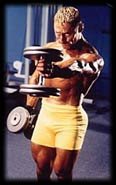
How many times have you waited for your favorite exercise, only to finally get on it and wonder, isn't there something more productive I could be doing for this bodypart? We are all so locked into using the most popular exercises year after year, when there are little-known or "lost" exercises that could be helping us pack on pounds of fresh muscle if we were only so adventurous as to try them. Over the years I have picked up a variety of obscure movements that every serious trainer should try.
Some are merely twists or improvements on existing exercises, while some are totally unique. They worked for the people I took them from, they worked for me, and they can work for you. Here, grouped by individual bodyparts, are fifteen power moves that you can start using today and kick-start your muscles into new dimensions.
Chest
Low Cable Crossovers
I'm quite sure national competitor Danny Hester didn't invent these, but it was a picture of him doing this variation on cable crossovers that inspired me to give them a try. Rather than affixing the pulley handles to the top pulleys, hook them to the bottom units. With a slight forward lean, begin with the handles a few inches behind the hips. Bring the handles up and together in a sweeping arc until your hands meet directly in front of the lower chest.
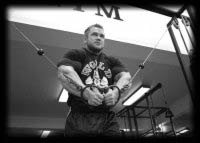
It is very similar in feel to decline flyes, but with a far more pronounced cramping sensation at the point of contraction. The contraction should be held for a full second for maximum benefit. It doesn't take a lot of weight to hammer the pecs into oblivion and pump them up to high heaven with this exercise. Care must be taken to avoid turning this into either a cable curl or front raises. With the arms kept slightly bent, it is possible to completely isolate the pecs.
Incline Cable Flyes
While you're there, you can also slide an incline bench in for incline cable crossovers. These are simply a cable version of incline dumbbell flyes, but the cables allow for resistance along the entire range of motion, something you will never experience with dumbbell flyes.
So many people complain of an inability to develop their upper pecs, never knowing that a great upper chest is in fact within their capabilities. Regular use of this exercise, especially when super-setted with any type of incline press, would do much to bolster very impressive growth in that much-lamented region.
Back
There are quite a few excellent exercises for back you've probably never tried, and that's a fortunate thing. Just about everybody could stand to improve their backs. Utilizing these movements, you're bound to start getting sore and growing in that bodypart that is so hard for most people to train effectively.
Top Deadlifts
I used to love to do regular deadlifts, but the problem was that if I trained legs with squats within two days before or after back, I was hitting the same muscle groups, namely lower back, hips, and quads, too close together to allow for recovery. I didn't want to stop deadlifting or squatting, as both exercises are excellent for building raw power and size. Then I read how Mike Francois varied his deadlifting, at times only performing partial reps.
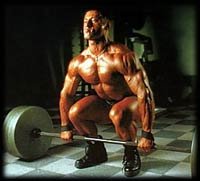
I experimented and found that by deadlifting in a power rack and only lowering the bar to my kneecaps, two huge benefits were obvious. One; by not pulling the bar from the floor I was no longer taxing the lower back and legs, and two, I could now use significantly more resistance. The top deadlift allows you to attack the entire middle and upper back with bone-crushing tonnage.
I was never able to do regular deadlifts with more than 455 pounds, but my top deadlifts routinely go up to six or seven plates a side. Be sure to warm up gradually, keep the lower back straight, and bend the knees as you descend. This one exercise has incredible potential for thickening up your back with meaty mass.
Lat Shrugs
Here's a truly unique exercise that hits the upper back muscles - the rhomboids and teres major and minors - like no other. These are the muscles that elicit gasps when properly developed in a rear double biceps pose. To do this exercise, lie facedown on an incline bench. Grab two dumbbells off the floor. Now, rather than shrug them, as the name implies, squeeze your shoulder blades together and hold the contraction for a full second.
It's nothing more than the reverse action of a hug, or trying to perform rear laterals as if you had no arms. The effect is an amazing pump, as this is probably the first time in your life these muscles will have received direct work. Pulldowns to the back of the neck hit this area, but the effect is blunted by the involvement of two weak links - your biceps and rear delts, which are far less powerful than the upper back.
You will be quite sore the next day the first two or three times you do lat shrugs. The reward, however, is striking development in a region of the back few people ever build to any degree.
Weighted Chins
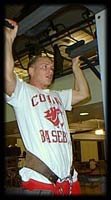 This is one exercise that shouldn't even be on this list. We all know it exists, yet every time I see someone chinning at the gym, they do the exercise without resistance, and with high reps. If anyone does a chinning motion with heavy weights, almost every time they're seated at a pulldown station. Yet both exercises, bodyweight chinups and pulldowns, are inferior for developing the entirety of the latissimus dorsi as the weighted chin..
This is one exercise that shouldn't even be on this list. We all know it exists, yet every time I see someone chinning at the gym, they do the exercise without resistance, and with high reps. If anyone does a chinning motion with heavy weights, almost every time they're seated at a pulldown station. Yet both exercises, bodyweight chinups and pulldowns, are inferior for developing the entirety of the latissimus dorsi as the weighted chin..
Chins are a harder and more productive movement because they require precise balancing. Whatever you do, you should always use a fairly narrow pronated (palms in toward you, underhand) grip rather than the much more popular wide overhand grip.
The underhand grip allows for almost a 50 percent greater range of motion. You wouldn't (I hope) do half-reps on squats or bench presses, yet so many trainers do a style of pulldowns that gives such limited results in relation to what is possible.
Show me a guy who can do ten reps of wide-grip pulldowns with 250 pounds, then compare his lat development to another guy who can do ten reps of chins with 150 pounds hanging from his waist. There would be no contest. The pulldown guy's back would be flat Kansas prairie next to the weighted chinner's Colorado Rocky Mountain Range. And, contrary to the name "chin up," chins should actually be performed leaning slightly back and pulling until the mid-chest hits the bar.
That is an enormous range of motion and works the lats like you've never known. It takes time to build up to respectable weight in the properly performed weighted chin, but it's worth the wait as it will help build a back that stands out in any crowd.
Cable Pulldowns to Side
This is nothing more than a one-armed cable pulldown with a twist - a twist of the body, that is. By simply turning your body to the side, you create a new angle of pull that shocks the lats into new growth. Since there is no reference point such as the chest to know when a full movement has been achieved, what you should do is attempt to pull the elbow into the waist.
You won't be able to reach it, but about 2/3 of the way there your lats will be completely contracted. Many studies have shown that a limb can generate more force unilaterally (with one hand) than when using both limbs at once. This is the main attraction of the Hammer Strength equipment line, an excellent group of machines that not all of us have access to.
E-Z Curl Rows
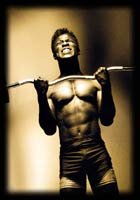 Thanks to Dorian Yates and his popularization of this unorthodox grip for barbell rows, we all learned about five or six years ago that the underhand grip works the lats harder, due to the biceps being in a more advantageous position to exert pulling force. But if you were like me, your wrists weren't used to turning that far. If also, like me, you were able to use a good deal of weight but had fairly small wrists, then you too probably also experienced terrible wrist pain using a straight bar.
Thanks to Dorian Yates and his popularization of this unorthodox grip for barbell rows, we all learned about five or six years ago that the underhand grip works the lats harder, due to the biceps being in a more advantageous position to exert pulling force. But if you were like me, your wrists weren't used to turning that far. If also, like me, you were able to use a good deal of weight but had fairly small wrists, then you too probably also experienced terrible wrist pain using a straight bar.
I read a back-training article by Jim Quinn years ago that told how he used an E-Z curl bar for just that reason. The trick is to wrap your straps directly in the center of where the bar curves for each hand.
By keeping the back at a 70- degree angle and pulling the bar into the gut, you will experience a hereto unknown pump and burn in the entire lat. Don't worry that you won't be able to use as much weight as with an overhand grip on a straight bar. The return is that your lats will receive a much more thorough beating and will grow larger.
Now that was a grouping of back exercises that could start putting former Mr. Olympia Dorian out of business as king of the freaky back department. If any of you have weak backs and continue to do your usual pulldowns and cable rows, you have no one to blame but yourselves. Back is one of the least intensely trained bodyparts in any gym, though it should receive as much or more attention and effort as chest or arms.
Triceps
Decline Smith Machine Close-Grip Presses
We always read about how one of the very top exercises for packing mass onto the triceps is the close-grip bench press. Surprisingly, I don't see too many people ever doing it. I wonder why that is? No, actually I know why. It will cause excruciating strain on the wrists for most trainers. I certainly couldn't do it.
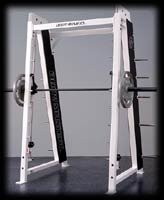
The solution is to change the angle of push by lying on a steep decline rather than a flat bench, and also to take away the strain of balancing a very heavy bar with a narrow grip by moving to a Smith Machine. These allow you to push the weights and concentrate on working the muscle instead of doing a circus balancing act.
Rope Kickbacks
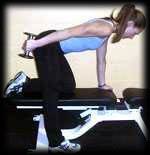 Dumbbell kickbacks are a great exercise for working the back head of the triceps, but they lose potential effectiveness by missing resistance in the bottom one-third range of motion due to the effects of gravity. A cable kickback would be a superior choice because it provides equal resistance along the entire range of motion.
Dumbbell kickbacks are a great exercise for working the back head of the triceps, but they lose potential effectiveness by missing resistance in the bottom one-third range of motion due to the effects of gravity. A cable kickback would be a superior choice because it provides equal resistance along the entire range of motion.
A neutral, or hammer grip is preferred, which becomes tricky with a cable handle. A better choice is a rope with a stopper at each end.
Slide the rope through so that all its length is on one side of the attachment, and you will have the perfect grip. Point your elbow so that your forearm is slightly higher than parallel, and go to town with a new quality of searing pump and burn in your triceps.
Legs
Reverse Hack Squat
Facing into the hack squat machine is actually how football players were taught to perform this exercise in years past to better simulate the wide-legs, low-to-the-ground tackling motion. While shooting the Flex Wheeler video Mass Construction a couple years ago, I watched Flex load up eleven plates on each side and grind out ten deep, torturous reps of reverse hacks that had his quadriceps and hamstrings bursting with fresh blood.
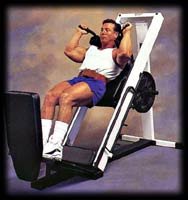
One look at his engorged thighs when he crawled out of there and I decided it was worth a try. One thing you will notice right away is that you have to put your feet wide, slightly angled out, and all the way at the bottom of the platform to be "centered" correctly. Once you get going, you'll see that your top weight on regular hack squats feels like a warmup here. What's more, you'll be hitting places like the inner thigh that regular hacks do nothing for.
One word of caution: since your back isn't supported, be sure to wear a sturdy lifting belt and keep the lower back from rounding. A spotter is also recommended to help you rack the weight from this awkward position. Work up to the bigger weights over a course of weeks, always keeping the lower back tight. But don't be scared off by all the precautions - this is one kickass power move for the legs!
Hamstring Hyperextensions
Many people have trouble with stiff-leg deadlifts and good mornings. For those with previous lower back injuries, using heavy weights is like skating on thin ice. Relax that lower back for a second, or go too low, and SNAP! It's all over but the Kleenex for your tears. Fortunately, a little twist to hyperextensions makes them a perfect substitute.
By simply keeping the glutes tensed, the workload will shift from the lumbar region to your hamstrings. Best of all, you won't need to add much resistance. Even someone who can use 300 pounds for stiff-leg deadlifts will get a great workout on hamstring hypers holding an 80 or 90-pound dumbbell. Used with leg curls, you'll have a complete hamstring workout with zero risk to the lower back.
Delts
One-Arm Side Laterals
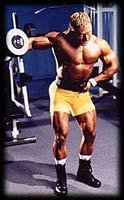 Again, I have to thank Mike Francois for this one. While shooting him for the American Muscle show back in 1995, he shocked me by doing this exercise with a 100-pound dumbbell, in contest condition. Watching his huge, melon delts get bigger and rounder-looking with each rep, I knew this was a better way to do side laterals. Using one arm at a time, you will be able to handle roughly 30 percent more weight than in the standard two-arm version.
Again, I have to thank Mike Francois for this one. While shooting him for the American Muscle show back in 1995, he shocked me by doing this exercise with a 100-pound dumbbell, in contest condition. Watching his huge, melon delts get bigger and rounder-looking with each rep, I knew this was a better way to do side laterals. Using one arm at a time, you will be able to handle roughly 30 percent more weight than in the standard two-arm version.
Strap the working hand into the dumbbell handle, then hold onto something steady with the other, such as an adjustable incline bench or the uprights of a power rack.
Leaning into the working shoulder and away from what you're holding onto, use just a touch of body English to power up the dumbbell until it's level with your shoulder. Attempt to bring it to a full stop, then lower slowly. This exercise is undefeated for slapping on meat onto the all-important side deltoid heads.
Traps
Armpit Rows
Armpit rows are a perfect exercise to superset with any kind of shrug for an intense trapezius workout. After doing a set of heavy barbell or dumbbell shrugs, grab a pair of dumbbells that are slightly more than half of what you can shrug. Beginning with the 'bells at your hips, pull each one straight up, trying as hard as possible to pull them into your armpits.
Because the traps are pre-exhausted from the shrugs, the pulling power of your fresh biceps and delts will allow you to drive them into the ground. Armpit rows are superior to barbell upright rows because they put the arms in a much more powerful pulling position close to your torso. The only problem you may experience is your traps growing up to your ears, making hearing difficult.
Biceps
Spider Curls
Millions of trainers rep away on the sloped side of preacher benches all over the world, not knowing that a better exercise is just 180 degrees away. By turning the pad around and performing spider curls on the straight-edged side of the bench, you get almost twice the range of motion. Spider curls allow you to lower the bar all the way to the bottom of the movement, giving you a stretch that will equate to more productive reps. Seeing as just about everyone wants bigger biceps, spider curls deserve to bump preacher curls off the list of "mandatory" arm exercises.
Drag Curls
The late Vince Gironda, the "Iron Guru." used to force everyone at his old gym in Studio City to try these if larger biceps were a stated goal. They are much like reverse curls in that they isolate the brachialis, a muscle on the outer head of the bicep which adds width when the arm is seen from the front. It's also a freaky, knotted muscle when seen in the rear double-biceps pose. To perform drag curls, keep the elbows in back of you rather than pinned at your side.
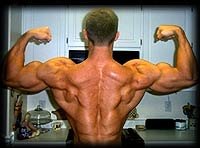
Using an overhand grip, curl the bar up and at the same time keep it in contact with your torso. In effect, you are dragging it up. Be sure not to let the elbows or shoulders rise up or this can turn into a half-ass upright row real fast. You won't need much weight to make your brachiali burn and ache like there are lumps of liquid fire buried within your outer biceps.
There you have it - fifteen exercises you almost never see done in the gym, yet all of which have the potential to improve your physique tremendously. Give each one a try over the next few weeks and see if one of them doesn't become a new favorite, or the solution to a stalled bodypart that hasn't grown in months. They might be obscure, but these power moves will definitely help put your body in the limelight it deserves!
Reprinted with permission from eMuscleMag.
You may contact Ron Harris at www.ronharrismuscle.com.
